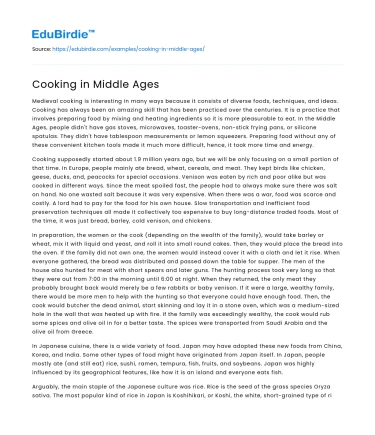Medieval cooking is interesting in many ways because it consists of diverse foods, techniques, and ideas. Cooking has always been an amazing skill that has been practiced over the centuries. It is a practice that involves preparing food by mixing and heating ingredients so it is more pleasurable to eat. In the Middle Ages, people didn't have gas stoves, microwaves, toaster-ovens, non-stick frying pans, or silicone spatulas. They didn't have tablespoon measurements or lemon squeezers. Preparing food without any of these convenient kitchen tools made it much more difficult, hence, it took more time and energy.
Cooking supposedly started about 1.9 million years ago, but we will be only focusing on a small portion of that time. In Europe, people mainly ate bread, wheat, cereals, and meat. They kept birds like chicken, geese, ducks, and, peacocks for special occasions. Venison was eaten by rich and poor alike but was cooked in different ways. Since the meat spoiled fast, the people had to always make sure there was salt on hand. No one wasted salt because it was very expensive. When there was a war, food was scarce and costly. A lord had to pay for the food for his own house. Slow transportation and inefficient food preservation techniques all made it collectively too expensive to buy long-distance traded foods. Most of the time, it was just bread, barley, cold venison, and chickens.
Save your time!
We can take care of your essay
- Proper editing and formatting
- Free revision, title page, and bibliography
- Flexible prices and money-back guarantee
In preparation, the women or the cook (depending on the wealth of the family), would take barley or wheat, mix it with liquid and yeast, and roll it into small round cakes. Then, they would place the bread into the oven. If the family did not own one, the women would instead cover it with a cloth and let it rise. When everyone gathered, the bread was distributed and passed down the table for supper. The men of the house also hunted for meat with short spears and later guns. The hunting process took very long so that they were out from 7:00 in the morning until 6:00 at night. When they returned, the only meat they probably brought back would merely be a few rabbits or baby venison. If it were a large, wealthy family, there would be more men to help with the hunting so that everyone could have enough food. Then, the cook would butcher the dead animal, start skinning and lay it in a stone oven, which was a medium-sized hole in the wall that was heated up with fire. If the family was exceedingly wealthy, the cook would rub some spices and olive oil in for a better taste. The spices were transported from Saudi Arabia and the olive oil from Greece.
In Japanese cuisine, there is a wide variety of food. Japan may have adopted these new foods from China, Korea, and India. Some other types of food might have originated from Japan itself. In Japan, people mostly ate (and still eat) rice, sushi, ramen, tempura, fish, fruits, and soybeans. Japan was highly influenced by its geographical features, like how it is an island and everyone eats fish.
Arguably, the main staple of the Japanese culture was rice. Rice is the seed of the grass species Oryza sativa. The most popular kind of rice in Japan is Koshihikari, or Koshi, the white, short-grained type of rice. This type of rice is used in almost everything, from sushi to chirashi bowls. Rice was cooked in different ways, it was boiled and steamed, or cooked and then dried. Rice was an important part of the Japanese diet because it was plentiful and inexpensive, so everyone, including the peasants, could enjoy it. The poorest of the poor would have eaten nothing else.
In Africa during the Middle Ages, people adapted various traditions and cultures from the Phoenicians, Greeks, and Romans. This started around 800 B.C., during the arrival of these invaders. The Africans started eating olives and producing olive oil. It grew so well and popular that they shipped it across the Mediterranean and as far as India. Africans also started eating beef and drinking milk. They were introduced to bananas and sugar that were imported from Madagascar, India, and Iran. Many of the foods they ate were bred in Asia and the Mediterranean. Medieval African foods were very different than at the time of the Iron Age.
In short, Africans ate coconuts, sugar, plantains, coffee, beans, bananas, couscous, rice, beef, and much, much more. Since their DNA adapted easily to new foods, the community could drink raw milk without getting hurt or poisoned. The whole family took part in preparing food. Men and older boys hunted animals, while women and young children picked fruits and vegetables. During the day, the family also baked thin wheat-bread cakes. Their cooking techniques consisted of roasting, boiling, steaming, and baking, much like how everyone cooks today.
The history behind cooking is delightfully engaging. With historical records, paintings, maps, artifacts, diaries and more, scientists and historians can go back in time to learn about the history of Medieval lifestyle, specifically food and cooking. Here we have 3 places: Europe (Denmark, England, Scotland, France, Germany, Ireland, Italy, etc.), Japan, and Africa (Ghana, Mali, and Songhai). In Europe, families cook birds, deer, wheat, and fruits. Japanese ate rice, fish, ramen, and soybeans. The Africans enjoyed eating wild buffalo, bananas, beans, rice, and drinking milk. With historical records, people can learn about different cultures all over the world at different times in history.






 Stuck on your essay?
Stuck on your essay?

